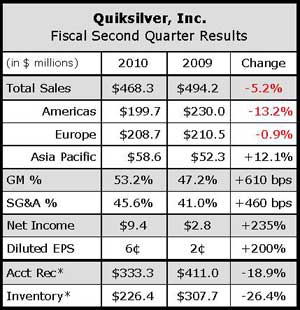Quiksilver, Inc. continued to move forward with solid profits in the company’s fiscal second quarter ended April 30 as net income surged 235% to $9.4 million, or 6 cents per diluted share, compared to $2.8 million, or 2 cents per diluted share, in the year-ago period. Sales declined 5.2% to $468.3 million in the second quarter from $494.2 million in the fiscal second quarter last year.
The company reported positive sell-through for seasonally popular items such as board shorts, walk shorts, T-shirts, wovens and sandals. Gains in these areas, however, were potentially offset by troubling numbers in the juniors market for all surf and skate apparel.

Gross margin improved 600 basis points to 53.2% of sales in fiscal Q2, compared to 47.2% of sales in fiscal Q2 last year, led by a 970 basis point improvement in the Americas. Europe margins also benefited from lower levels of discounting in both wholesale and retail distribution, as well as a reduction in the volume of clearance items.
Stability within the company’s DC brand helped offset slight declines at Quiksilver and Roxy. Moreover, the company was able to control inventories in line with demand amid seemingly improved U.S. market conditions, resulting in even lower levels of discounting and clearance sales, helping offset the 5% decline in revenues.
With inventories down 26% at quarter end to $226 million, and down 30% in constant currency compared to the same period last year, business in the Americas accounted for approximately three-quarters of the reduction. Revenues for the region were down to $199.7 million, compared to $230 million in the prior year.
In Europe, net revenues were down 0.9% to $208.7 million from $210.5 million in the fiscal second quarter 2009 thanks to a much weaker euro currency. In constant-currency terms, sales were off 5% for the period. Gross margin improved 320 basis points to 59.5% of sales from 56.7% in the second quarter of fiscal 2009, again making Europe both the largest region for the company and the most profitable as the region posted operating margins of 18.8% for the quarter.
Within Europe, the DC brand continued to grow well, partially offsetting declines in both Quiksilver and Roxy.
Expenses in Europe were higher in constant dollars compared to last year, primarily due to costs associated with stores opened during the past year, and some additional bad debt expense. As a result of those factors, the company generated pro forma operating income of $43 million in the second quarter, better than 9% of sales, which is up from $33 million or 6.6% of sales in the same quarter a year ago.
Revenues in the Americas were down 13.2% to $199.7 million for the quarter. Management said contraction in the wholesale channel was “slightly offset by modest growth” in their owned-retail stores.
The Quiksilver and DC brands were said to be “approximately flat” in the U.S. when compared with last year, while Roxy was down in the quarter, which management said was consistent with the continued challenges that the juniors business represents for the company and their peers in the market.
Owned-retail store comps in the U.S. were said to be “modestly positive” overall in Q2 as both Quiksilver and DC posted “strong in-store gains” in the quarter. Quik has closed a net of 12 underperforming company-owned retail stores in the Americas since the end of the second quarter 2009.
The Americas posted a 970 basis point improvement in gross margins for the period.
The Asia-Pacific region saw a 12.1% gain in revenue to $58.6 million-though due to sizable shifts in the yen-the Australian dollar; and the U.S. dollar in relation to one another, business in the region appeared stronger than actual. Constant-currency revenues fell 17% for the quarter in the region. The Asia-Pacific business was down in the high-single digits on a percentage basis primarily due to softening trends throughout the region. Still, new store openings helped retail business grow revenues in comparison to last year.
Net debt at quarter-end was $733 million, reflecting a reduction of $201 million compared to a year ago.
Looking ahead, the company expects revenues to be down in the low teens based on a fall in the value of the euro versus the U.S. dollar as well as lighter trends in the Asia-Pacific region. Third quarter diluted EPS are expected to be in the low-single digit range.
While inventory levels parallel demand for their products, Quiksilver expects to be able to deliver between 450 and 500 basis points of gross margin improvement in the third quarter compared to last year's margins. Operating expenses in the third quarter are expected to be as much as 5% lower than in the third quarter of fiscal 2009.













